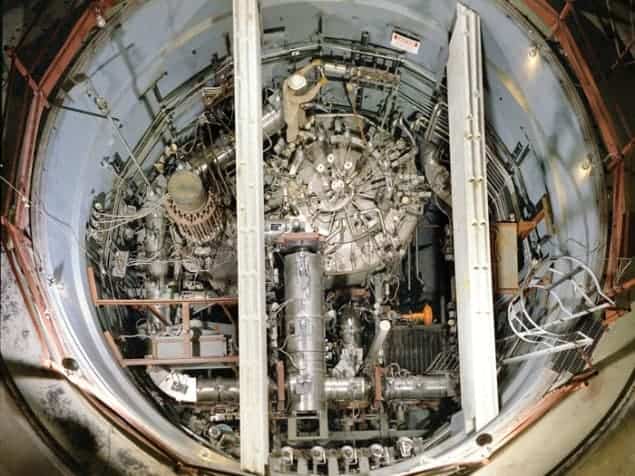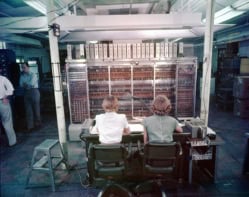Jess Gehin reviews Superfuel: Thorium, the Green Energy Source for the Future by Richard Martin

As an alternative to uranium as a fuel for reactors, thorium has been debated and evaluated since the dawn of the nuclear era. The primary reason for considering thorium is concern over scarcity of uranium resources, and this remains the reason why countries with limited supplies of uranium, such as India, are developing thorium-based technologies (see Physics World June 2012 pp12–13).
Richard Martin’s book Superfuel seeks to build support for expanding such developments. Written as a follow-up to his December 2009 article in Wired magazine on the same subject, Martin’s book covers three topics related to thorium: the technical and engineering aspects of its use; the historical context for its development as a nuclear fuel; and a commentary on the current nuclear energy industry and its acceptance of new technologies. The book is not intended for a technical audience, but rather for those who support the “cause” of using thorium as a future fuel for reactors. This includes organizations such as the Thorium Energy Alliance, the International Thorium Energy Organization and several other thorium advocates quoted and mentioned in the book.
My own perspective on this “cause” is that thorium is a potential fuel cycle option that deserves to be considered. Unfortunately, the book contains a number of embellishments, incorrect characterizations and erroneous bits of information regarding the use of thorium, most of which seem to place thorium in a more positive light. This certainly diminishes the book’s value to more technical readers, and could potentially mislead those who are not knowledgeable in this area.
In any discussion of nuclear energy, the relevant technical areas are safety, sustainability and nuclear waste, and indeed Martin discusses these throughout the book. But while he attributes aspects of safety, plentiful supply and beneficial waste characteristics to thorium, most of these features are in fact more closely related to a specific reactor technology – the molten salt reactor (MSR), also called a liquid fluoride thorium reactor (LFTR) in this book – rather than to thorium itself.
MSR-type reactors use fuel dissolved in a high-temperature liquid salt, which offers a high degree of safety because – in the event of an accident – the liquid fuel can passively drain from the reactor core into tanks cooled by natural circulation. The molten salt design also allows for an optimized use of thorium in thermal-spectrum breeder reactors, and between the 1940s and the 1970s, researchers at Oak Ridge National Laboratory (ORNL) developed the concept of a molten salt breeder reactor (MSBR) that used fertile thorium to produce fissile uranium-233 as a fuel. The MSBR programme successfully demonstrated the operation of an MSR with an experiment that ran from 1965 to 1969. The programme ended when the US Atomic Energy Commission (AEC) decided put all of its resources into developing a sodium-cooled fast reactor (then called the liquid-metal fast-breeder reactor) that allows effective breeding using a uranium-plutonium fuel cycle.
Another potential source of confusion is the book’s claim that one tonne of thorium produces as much energy as 200 tonnes of uranium. This is true if we are comparing an advanced thorium-fuelled reactor (which would incorporate a full system of fuel recycling) with the current generation of uranium-fuelled light water reactors (which use fuel in a “once through” fashion, and which in the US were mostly designed and built in the 1970s and 1980s). However, the claim is not accurate if we instead compare the thorium proposals with advanced reactors and associated technologies that use uranium, such as the sodium-cooled fast reactor mentioned earlier. In the latter case, the energy generated by thorium and uranium will be comparable.
The middle part of Superfuel covers the historical context for the development of thorium-based nuclear technology. In these chapters, Martin discusses the contributions of pre-eminent historical figures such as Alvin Weinberg, Eugene Wigner and Admiral Hyman Rickover to technologies such as MSRs and light water breeder reactors. Weinberg, for example, served as ORNL’s director when the MSR was being developed, but left in 1972 when he was “fired” (according to Weinberg himself) after falling out with AEC managers over reactor safety. Martin’s discussions of this period parallel those found in books such as Weinberg’s own The First Nuclear Era (AIP Press, 1994), and provide a good background on thorium research in the US through the 1970s.
The author also presents a high-level account of the history and context of India’s thorium nuclear energy development programme. This account includes Martin’s own commentary on what he perceives to be the implications of historical events that support his arguments for the benefits of thorium, as well as events that led to the demise of thorium projects. These historical sections of the book are well written and will be captivating for those interested in the history of the development of nuclear energy. In addition, he discusses future nuclear technologies such as Generation IV nuclear energy systems (which comprise six reactor types, including the thorium-fuelled MSR) and their implications regarding nuclear waste. Comparisons between nuclear and other forms of energy are also debated.
The final chapters of the book contain a great deal of commentary on the possible deployment of thorium-based technologies. Martin is very critical of current light water reactor technologies, focusing on events such as those at Japan’s Fukushima Daiichi plant after the 2011 earthquake and tsunami. His comments are very likely to turn off those, such as myself, who believe that today’s nuclear reactors are reliable and safe in the context of our current regulatory framework and compared with other, non-nuclear energy technologies. In particular, Martin’s use of terms such as “wooden-headedness” and “nuclearati” to characterize the nuclear industry as anti-thorium and closed to new developments is inflammatory, and may alienate the thorium movement from the very people who would ultimately implement it.
Overall, while Superfuel does provide useful historical information on the thorium movement, I would not recommend it as a source of technical information about thorium as a nuclear fuel. Most knowledgeable readers will cringe at a few of the technical characterizations, and will be concerned about many of the claims attributed to thorium. Instead, Superfuel should be read as an advocacy book, one that is largely written for an audience interested in the expanding thorium energy movement. In that context, it provides good insight into how the movement characterizes the use of thorium in comparison to uranium-based technologies.
- 2012 Palgrave Macmillan £18.99/$27.00hb 272pp



